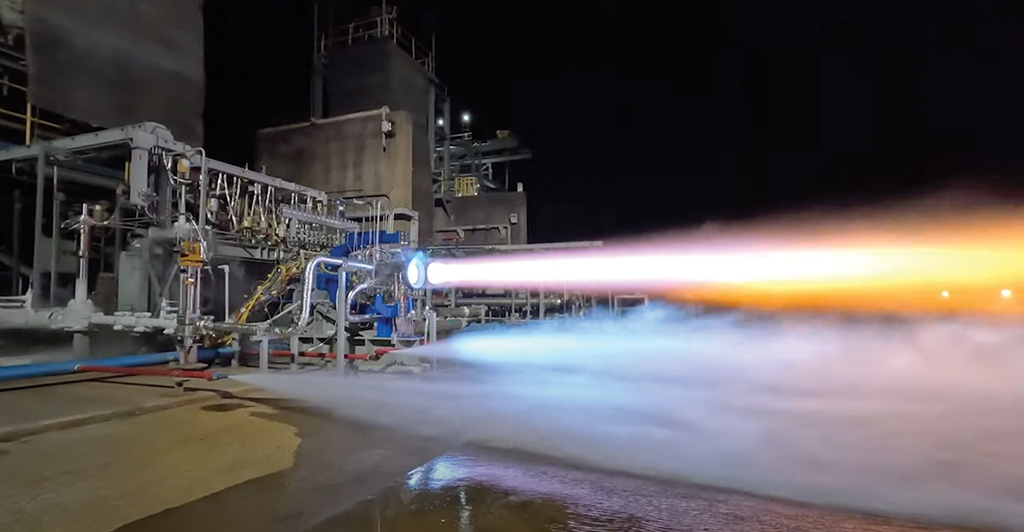
A camera on the uncrewed Orion spacecraft captured this view of the Moon on Nov. 20, 2022, the sixth day of the Artemis I flight test.
Beyond geosynchronous orbit is an enormous volume of space that falls under the gravitational influence of Earth and/or the Moon. Known as cislunar space, the region is beginning to hold sway for a growing number of companies seeking to serve government customers as well as develop new commercial markets.
“Cislunar space offers tremendous promise for advancing science, technology and exploration,” the White House’s National Science and Technology Council (NSTC) concluded in a November 2022 report. “The decade ahead is critically important for exploration of cislunar space, including the lunar surface.”
- White House unveils cislunar space strategy
- Blue Origin eyes array of lunar services
With its own Artemis lunar exploration program as the centerpiece, NASA estimates that the next decade will bring more human activity in cislunar space than what has occurred since the Space Age began in October 1957 with the launch of Sputnik by the Soviet Union. The evolving cislunar ecosystem includes not just government programs but commercial, nonprofit and academic initiatives as well.
Among the most prominent individuals who have set their sights beyond Earth are billionaire technology entrepreneurs Jeff Bezos and Elon Musk. Their privately owned space companies, Blue Origin and SpaceX, hold NASA contracts worth a combined $7.6 billion for demonstration flights and three missions to ferry astronauts to and from lunar orbit and the surface of the Moon. The companies are contributing billions more of their own funds to develop Human Landing Systems (HLS), in hopes of winning not only future NASA flight service contracts but also other lunar services business from commercial companies, research organizations and private space travelers.
The most recent NASA award went to Bezos’ Blue Origin. After losing out on NASA’s first HLS contract award to Musk’s SpaceX in 2021, Blue Origin in May clinched a $3.4 billion deal to lead a team that includes Lockheed Martin, Boeing, Draper and others to develop an HLS for the agency’s Artemis V mission, targeted for 2029.
While it has several technologies in development for the so-called Blue Moon lander, the company is parlaying lessons learned from its 10-year-old New Shepard suborbital transportation system and upcoming New Glenn reusable orbital launcher.
“We try not to learn the same lesson twice,” John Couluris, HLS program manager at Blue Origin, tells Aviation Week. In addition to flying Blue Moon landing system sensors on New Shepard flights, teams are training on fueling, ground support and other operations.
The Blue Moon lander is a 52.5-ft.-tall reusable vehicle powered by liquid hydrogen and liquid oxygen and outfitted with a trio of BE-7 engines. The lander, internally referred to as the Mark-2 (MK2) design, is intended to support four astronauts for up to 30 days. The system would be refueled between missions by a Lockheed--provided cislunar transporter comprised of a tug and a tanker, each of which would launch separately on New Glenn rockets. A third New Glenn rocket would carry the Blue Moon lander.
Ahead of flying an uncrewed MK2 lander, the company intends to conduct a series of flight tests with a pair of single-engine Blue Moon Mark-1 (MK1) vehicles. “We are planning to have two launched and successful for our flight-test objectives no later than 2026,” Couluris says.
The MK1s are smaller spacecraft designed to eventually land up to 3.3 tons anywhere on the lunar surface, night or day. The MK1 uses the same flight computers, avionics architecture, reaction control system and power system planned for the MK2.
“Originally, the MK1 lander was our effort to fast-track development and get experience on orbit and on the lunar surface and to learn how to land vehicles,” Couluris says. “However, it’s actually evolved into a product of its own. We have customers who are interested in utilizing the lander’s capabilities to get access to the Moon. So we’ll fly two of those, and that will lead up to our first uncrewed MK2 Blue Moon lander.”
The first MK1 mission is primarily targeted toward maturing the lander systems. “I’m not actively looking to put customers on Serial No. 1. For Serial No. 2, we’ve received a lot of interest from customers to fly independent payloads,” Couluris says.
With the capability of carrying 3.3 tons, the MK1 “becomes a very interesting lander by itself,” he adds. “You can offload lunar terrain vehicles. You could make the MK1 lander a base station so you can explore different areas of the Moon. That vehicle can serve as your power station and your communications relay station so you don’t have to carry all that mass on other rovers, for example.”
The MK1 flights would pave the way for an uncrewed MK2 mission slated for 2027, followed by the first crewed Blue Moon mission as part of the Artemis V flight.
Blue Origin declined to discuss prospective customers, but in addition to lunar landings, the Blue Moon program is expected to sell cislunar transportation and other services. “The cislunar transporter is utilizing common systems, including three BE-7 engines—the same engines that power the Blue Moon lander. We’re very closely tied with Lockheed Martin and our entire national team,” Couluris says.
Lockheed is contributing “heritage hardware” developed for NASA’s Orion spacecraft, as well as for the company’s commercial satellite business. The cislunar transporter also is being designed to carry what is a key technology development for the Blue Moon program—a solar-powered, zero-boil-off system for storing cryogenic propellants in space.
The tug and the tanker are planned to launch on two separate New Glenn vehicles and then dock in low Earth orbit (LEO) to form the cislunar transporter. “It’s a very exciting vehicle because not only does it allow us to utilize refueling services, which really will build the cislunar ecosystem, but it also could be a depot to store propellants—utilizing zero-boil-off systems—close to indefinitely. That is what we are targeting, eventually,” Couluris says.
Once assembled in LEO, the cislunar transporter would be refueled by the second stage of New Glenn, which would dock with the transporter and transfer liquid oxygen and liquid hydrogen. The transporter would then fly to the lander, located in a near--rectilinear halo orbit around the Moon, and dock.
In between servicing the Blue Moon lander, the cislunar transporter could tend to other customers. “We do believe there is a demand to go do in-space transportation,” says Kirk Shireman, Lockheed Martin Space’s vice president for the lunar exploration campaign.
Cislunar space is more than 2,000 times larger than the region of space within geosynchronous orbit and spans more than 12 times the distance between Earth and geosynchronous orbit, which is about 22,300 mi. away.

“Spacecraft can operate in a variety of trajectories in cislunar space including lunar orbit, translunar trajectories and families of orbits in the large regions around Earth-Moon Lagrange points,” notes the NSTC report.
NASA kicked off commercial missions to the Moon in 2018 with a program to buy flight services for small science experiments and payloads using privately developed, owned and operated vehicles. The first Commercial Lunar Payload Services (CLPS) mission, contracted to Pittsburgh--based Astrobotic Technology, is slated to launch late this year or in early 2024 on United Launch Alliance’s inaugural Vulcan rocket flight. The mission, last scheduled for May, has been delayed for modifications of the booster’s Centaur V upper stage after a test vehicle failed a structural qualification test in March.
NASA in April removed half the payloads originally manifested to fly on Astrobotic’s Peregrine Lander “to maintain performance margins in Peregrine’s descent to the lunar surface,” the agency said. The payloads are to be reassigned to future CLPS, international or Artemis HLS missions, NASA added.
In addition to five NASA payloads, the Peregrine lander, which has a mass capacity of about 200 lb., is planned to carry more than a dozen scientific instruments, technologies, mementos and other cargo from researchers and individuals.
NASA has active contracts for eight CLPS missions slated to fly in 2023-26, with two task orders to Astrobotic, three to Intuitive Machines, two to Firefly Aerospace and one to Draper.
The companies are among 84 businesses identified in a 2020 report by the Institute for Defense Analyses’ Science and Technology Policy Institute with planned commercial cislunar activities through 2040. The single largest industry was transportation, with 36 companies—or 43%—selling or planning to sell flight services. That was followed by lunar resource utilization at 18 companies (21%), 17 companies (20%) working on structures and habitats and 13 companies (15%) providing supply chain manufacturing in support of lunar operations.
In addition to the above, the report identifies three companies that plan to offer position, navigation and timing (PNT) services, five planning to sell private goods and two eyeing science or data collection services.
The report, “Demand Drivers of the Lunar and Cislunar Economy,” determined that about $63 billion could be available to the private sector in 2024-40 from the U.S. and other governments in support of human lunar exploration activities.
The Biden administration in November released the country’s first blueprint for interagency research on cislunar space activities, building on the U.S. Space Force’s priorities for cislunar operations. The National Cislunar Science and Technology Strategy represents the first U.S. effort to build a “whole-of-government strategy for advancing scientific, exploration and economic development activities in cislunar space,” the document said.
The strategy for cislunar operations includes:
- Supporting research and development to enable future growth.
- Expanding international science and technology cooperation.
- Extending U.S. space situational awareness capabilities.
- Implementing cislunar communications and PNT capabilities with scalable and interoperable approaches.
The three Space Force priorities for cislunar operations are communications, PNT and monitoring spacecraft and space debris. The service last year established a new unit, the 19th Space Defense Sqdn., to monitor the region beyond geosynchronous orbit, including cislunar space.
